Oil Spills
-
- Best Effort Response To Cleaning Up Oil Spills Maritime Reporter, Apr 1991 #76
Marine Spill Response Corp. Projects 5-Year, $800 Million Program Two years ago, on a reef in Alaska's Prince William Sound, the oil tanker Exxon Valdez ran aground causing America's biggest oil spill.
While thousands worked to clean up the spill in Alaska, in Washington, a task force representing America's oil industry, set about studying the existing resources across the nation for responding to catastrophic oil spills.
As a result of task force recommendations, 20 oil companies began the process of creating the Petroleum Industry Response Organization (PIRO) to manage catastrophic spills. In August 1990, the oil companies created two new organizations: the Marine Spill Response Corporation (MSRC) and the Marine Preservation Association (MPA). MSRC, which has succeeded PIRO, is an independent oil spill response organization.
MSRC will operate from five Regional Response Centers, each supported by several strategically placed equipment sites along the coast, and will become the nation's largest spill response and cleanup organization. MPA, an organization comprised of oil companies and the shippers and receivers of oil, will fund MSRC but have no control over operations.
MSRC is headquartered in Washington, D.C., with our five regional response centers located along the coastal United States in the New York/New Jersey area, south Florida in Miami/Port Everglades area, the Lake Charles/Hackberry, Louisiana area in the Gulf, Port Hueneme, California in the Southwest, and the Seattle, Washington area in the Northwest.
Each region will have four to six prestaging areas (22 in all) where equipment, supplies and sometimes vessels and personnel will be located.
Each site has been selected to enable a quicker response to a large spill in areas of greater oil movements, and hence risk, along the coast.
MSRC, under the direction of the Coast Guard, will provide a "besteffort" response to cleaning up spills of persistent (crude) oils that are beyond the capacity of local response organizations. Each of five regional centers is designed to provide this "best effort" response to spills. MSRC's response capabilities are being designed based on a spill roughly the size of the Alaska spill.
Operationally, the nearest equipment/ resources will be brought to the scene. In the event of an even larger spill, some of the resources of two or more regions may be combined.
MSRC's five-year costs for operations, capital equipment, and research and development are estimated at more than $800 million.
These costs are funded through MPA members' annual dues, which will be based on the number of barrels of oil transported in the previous year. In the event an MPA member becomes a spiller, MSRC will be available to aid the spiller, consistent with its agreement with the spiller and the direction of the Coast Guard. The spiller—not MPA or MSRC—will pay for the actual cleanup.
Although MSRC is a private organization that will work closely under contract with a spiller, it will also work closely with government efforts. MSRC will be available to execute the appropriate portions of the spiller's response plan. Under the Oil Pollution Act, spillers must respond under the direction of the Coast Guard during major oil spills in coastal areas. The presence of the Coast Guard at a spill site does not relieve spillers of their responsibilities for funding the clean up. The Coast Guard must, however, provide clear direction and coordination of cleanup operations when spills or potential spills pose a substantial threat to the public health and safety.
MSRC is not intended to replace existing oil spill cooperatives and independent response contractors.
In fact, MSRC will use co-ops and independent responders as subcontractors for major spills and will train and drill with them. These existing entities have done a good job handling smaller spills. MSRC will only act when this infrastructure does not have sufficient resources for larger spills.
Under federal law, the responder to an oil spill has limited immunity.
He is not liable for removal costs or damages unless he acts with gross negligence or willful misconduct.
This limited immunity does not involve cases of personal injury or wrongful death. Under some state laws, however, the responder is not provided this limited immunity.
MSRC is seeking state liability standards that are the same as the federal standard. This standard is appropriate because an oil spill responder must act decisively in a dynamic environment. Moreover, responders frequently must act with less than perfect information.
Another unique aspect of MSRC will be administration of a research and development program to improve the technology and knowledge used to respond to and clean up spills. This program will complement others in government, academia, and industry. MSRC plans to study such subjects as prevention of oil loss from damaged ships, onwater oil recovery and treatment, prevention and mitigation of shoreline impacts, fate and effects of spilled oil and petroleum products, mitigation of adverse effects on wildlife, and health and safety.
MSRC will also aim to develop standards of oil spill response equipment, techniques and training.
MSRC plans to be fully operational by February 1993—the date when the Oil Pollution Act requires owners and operators of vessels, terminals, pipelines and offshore platforms to submit comprehensive spill response plans. Much must be done in the intervening two years.
A detailed implementation plan has been developed for MSRC, with most of the plan still in the process of being implemented. Equipment and vessels are being procured. Regional Response Centers must be surveyed and acquired. Land and buildings are being purchased or leased. Personnel—including hundreds of subcontractors—must be hired, trained and integrated into MSRC operations. Insurance must be arranged, and the research and readiness programs must be launched.
The Oil Pollution Act of 1990 requires that shippers and others responsible for oil transported on offshore and tidal waters show they can, to the maximum extent practicable, remove a "worst case" spill they might cause. This capability must reside in the private sector, and many companies may want to rely on MSRC to meet important federal response requirements, rather than obtain other response and cleanup capabilities.
-
- Floating Weir Skimmer Collects Oil Spills In Harbors Or Offshore Maritime Reporter, Feb 15, 1981 #42
The Skim-Pak floating weir skimmer is a rapid response, oilspill cleanup tool for use in the harbor or at dockside, yet it works well in the rough, high seas. Skim-Pak systems are said to recover up to 4,000 bhp at excellent oil to water recovery ratios. Used as a "first line of defense," Skim-Pak
-
- Australia Fights Oil Spills With MARCO Class I Skimmers Maritime Reporter, Jan 15, 1981 #6
, and can be deployed quickly from these centers to any spill site. With a top speed of 18 knots, the Class I is ideal for rapid first response to oil spills on waterways, bays, and harbors. Once at the spill site, the Class I skims at approximately 2-3 knots and removes all oil and debris from its
-
- Use Of Combustion To Combat Oil Spills —Report Available Maritime Reporter, Mar 1980 #46
Practical information on using combustion to combat oil spills is contained in a report released recently by the Department of Energy's Pacific Northwest Laboratory (operated by Battelle Memorial Institute). The purpose of the report is to provide decision-makers with information they can use when
-
- IMO Forum To Address High-Density Oil Spills Maritime Reporter, Nov 2000 #24
(MEPC 45), it was agreed to hold a Research and Development Forum in March 2002, which will focus primarily on response to spills of highdensity oil. France will host the forum, which will be the third R&D Forum sponsored by IMO. High-density fuel oils such as that carried by Erika are among
-
- USCG Developing Rules Requiring Vessels To Respond To Oil Spills Maritime Reporter, Nov 1991 #138
Regulations mandated by Congress in the Oil Pollution Act of 1990 to minimize the impact of oil spills include the requirements that all domestic and foreign tanker-type vessels operating in U.S. waters have onboard oil-spill-removal equipment as well as an oil-spill-response plan. In an advanced
-
- Expanded Underwater Robotics Ready for Oil Spills Marine Technology, Mar 2018 #24
of the Balearic Islands - UIB, 11Norges Teknisk-Naturvitenskatelige Universitet – NTNU, 12Marine Technology Unit CSIC. Tracking in-water oil spills before reaching the surface by using new emerging robotic technologies is bridging the gap between existing traditional technologies (modelling and
-
- INTERNATIONAL OIL SPILL CONFERENCE Maritime Reporter, Feb 15, 1983 #14
from all over the world are expected to attend. More than 100 technical papers dealing with the prevention, behavior, control, and cleanup of oil spills will be presented. A number of films will also be shown. The conference will stress prevention and control techniques; cleanup operations; contingenc
-
- OIL SPILL CONFERENCE Maritime Reporter, Feb 15, 1985 #30
110 presentations that will spotlight the latest pollution response equipment and research. Topics scheduled include the case histories of several oil spills, new cleanup techniques and equipment, legal concerns, contingency plans for spills around the world, and a discussion of how oil affects the marine
-
- Louisiana Officials Create Oil Spill Cleanup Tax Maritime Reporter, Apr 1991 #65
A fund to clean up oil spills that calls for a two-cents-per-barrel tax on crude oil transferred from barges or tankers at marine facilities in the state is being created by Louisiana officials. Estimated at $10 million annually, the fund would be administered by a coordinator within the office
-
- Answering the Call for Environmental Answers Marine News, Sep 2018 #50
inland and offshore environments and tested them in the Kalamazoo River and Lake Huron.Whenever there is a need for oil, there will always be a risk of oil spills. This is no less true for bituminous sands, commonly known as oil sands or tar sands. Oil sands are mostly found in Alberta, Canada, and comprised
-
- Oil Under Ice Maritime Reporter, Mar 2015 #56
Regions Research and Engineering Lab How did an urgent requirement to build a road to Alaska end up helping to design submarines and to recover oil spills in the Arctic ice? The Army Corps of Engineers was faced with a monumental challenge of building a highway to connect the “lower 48” to Alaska during
-
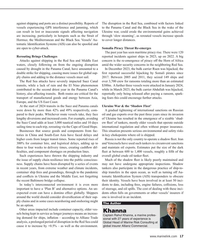 )
June 2024 - Maritime Reporter and Engineering News page: 17
)
June 2024 - Maritime Reporter and Engineering News page: 17more dents to date, including ? res, engine failures, collisions, loss important to have a ‘Plan B’ and alternative options. An un- of steerage, and oil spills. The cost of dealing with these inci- expected event can have a domino effect globally. Shippers dents often falls on governments or other vessels’
-
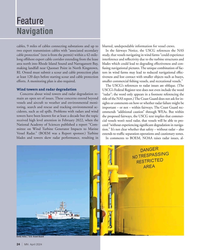 )
April 2024 - Marine News page: 24
)
April 2024 - Marine News page: 24failure might be toring, search and rescue and tracking environmental ac- important – or not – within fairways. The Coast Guard rec- cidents, such as oil spills. Problems with radars and wind ommends “additional caution” through WEAs. But within towers have been known for at least a decade but the topic
-
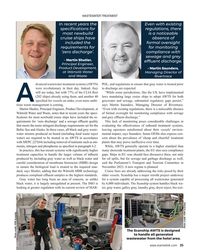 )
January 2024 - Maritime Reporter and Engineering News page: 35
)
January 2024 - Maritime Reporter and Engineering News page: 35volume of in? uent gaps. Ships in EU seas should face dissuasive ? nes, not only produced by including gray water as well as black water and for oil spills, but for sewage and garbage discharge as well, careful consideration of membrane bioreactor (MBR) design said the Parliament’s Transport and Tourism
-
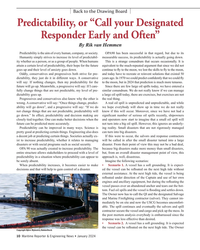 )
January 2024 - Maritime Reporter and Engineering News page: 10
)
January 2024 - Maritime Reporter and Engineering News page: 10the moon, but in 2024 that prediction is much more tenuous. future will go up. Meanwhile, a progressive will say: If I care- Since there are few large oil spills today, we have entered a fully change things that are not predictable, my level of pre- similar conundrum. We do not really know if we can manage
-
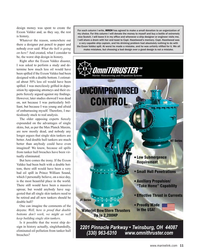 )
December 2023 - Maritime Reporter and Engineering News page: 11
)
December 2023 - Maritime Reporter and Engineering News page: 11longer argues that single skin tankers are better. And double hull tankers are much better than anybody could have even imagined! We know, because oil spills from tanker hull breaches have been vir- tually eliminated. But here comes the irony. If the Exxon Valdez had been built with a double bot- tom
-
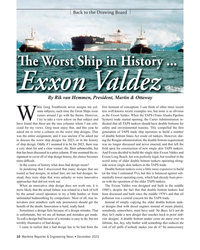 )
December 2023 - Maritime Reporter and Engineering News page: 10
)
December 2023 - Maritime Reporter and Engineering News page: 10of bad design. lifetime, but, hey, why bother with something that reduces the I came to realize that a bad design has to be bad from the risk of oil spills if nobody makes you do it? So unnecessary 10 Maritime Reporter & Engineering News • December 2023 MR #12 (1-17).indd 10 12/5/2023 9:49:38 A
-
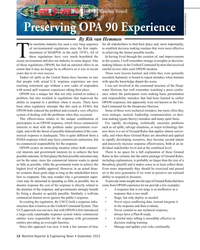 )
September 2023 - Maritime Reporter and Engineering News page: 12
)
September 2023 - Maritime Reporter and Engineering News page: 12was in recent careful review after each OPA90 incident. years due to its own success. These were lessons learned, and while they were generally Tanker oil spills in the United States have become so rare recorded, humanity is bound to repeat mistakes when humans that people with actual U.S. response experience
-
 )
April 2023 - Maritime Reporter and Engineering News page: 24
)
April 2023 - Maritime Reporter and Engineering News page: 24, such as High Pressure – High Temperature projects This industry’s been around for a long time; onshore here to new technologies available to address oil spills, such as domestically, offshore internationally. There’s a lot of regu- the Low-Emission Spray Crude Oil Combustor technology latory insights that
-
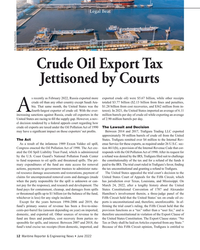 )
June 2022 - Maritime Reporter and Engineering News page: 12
)
June 2022 - Maritime Reporter and Engineering News page: 12for by the U.S. Coast Guard’s National Pollution Funds Center a refund was denied by the IRS, Tra? gura ? led suit to challenge to fund responses to oil spills and threatened spills. The pri- the constitutionality of the tax and for a refund of the funds it mary expenditures of the fund are state access
-
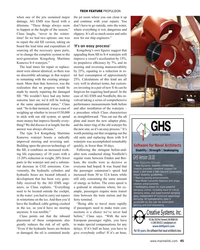 )
April 2022 - Maritime Reporter and Engineering News page: 45
)
April 2022 - Maritime Reporter and Engineering News page: 45the inboard before,” Claus says. “With the new placement of these components also European passenger rights, you have greatly reduces the risk of oil spills. to make special compensations for any “Even if the hydraulic hoses are broken delays. If it’s half an hour, you have to or damaged, the oil
-
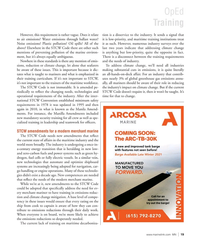 )
March 2021 - Marine News page: 19
)
March 2021 - Marine News page: 19air emissions? Water emissions through ballast water? it is low-priority, and maritime training institutions treat Noise emissions? Plastic pollution? Oil spills? All of the it as such. However, numerous industry surveys over the above? Elsewhere in the STCW Code there are other such last two years indicate
-
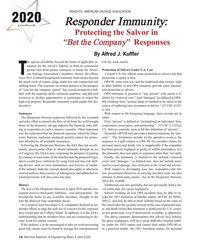 )
June 2020 - Maritime Reporter and Engineering News page: 14
)
June 2020 - Maritime Reporter and Engineering News page: 14or guilty of willful misconduct; (iv) of Congress The ASA is now examining the prospect of gaining the immunity does not apply to responses other than “oil spills by contract at least some of the benefts that the proposed legis- Finally, the immunity is limited to the defned “removal lation would have conferred
-
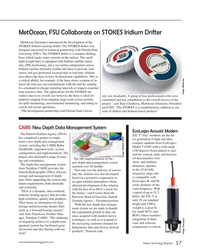 )
May 2020 - Marine Technology Reporter page: 57
)
May 2020 - Marine Technology Reporter page: 57of true professionals who were purposes ranging from mapping large-scale ocean currents, committed and key contributors to the overall success of the oil spills monitoring, environmental monitoring, and aiding in project.” said Tony Chedrawy, MetOcean Telematics President search and rescue operations. and
-
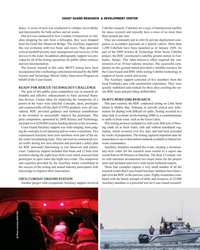 )
May 2020 - Maritime Reporter and Engineering News page: 51
)
May 2020 - Maritime Reporter and Engineering News page: 51in Mobile Bay, Alabama, to provide critical new infor- sidered. RDC provided guidance and technical contributions mation for dealing with diffcult oil spills. Testing occurred in a to the inventors to successfully improve the prototypes. This large tank to evaluate in-situ burning (ISB) as a countermeasure
-
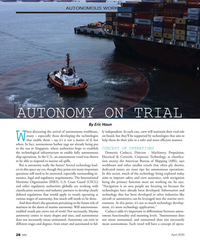 )
April 2020 - Marine News page: 28
)
April 2020 - Marine News page: 28ship operations. In the U.S., an autonomous vessel was shown Electrical & Controls, Corporate Technology, at classi?ca- to be able to respond to marine oil spills. tion society the American Bureau of Shipping (ABS), says But is autonomy really the future? Several technology lead- workboats and other smaller
-
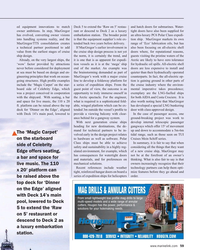 )
March 2020 - Maritime Reporter and Engineering News page: 59
)
March 2020 - Maritime Reporter and Engineering News page: 59for expedi- Arctic are likely to have zero tolerance ‘wow’ factor provided by attractions tion vessels as it is at the ‘mega’ ship for hydraulic oil spills. All-electric shell never before considered for deployment end of the market. An example was doors are less expensive to install and at sea must
-
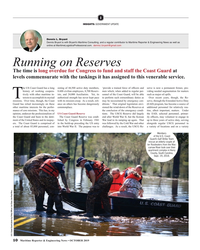 )
October 2019 - Maritime Reporter and Engineering News page: 10
)
October 2019 - Maritime Reporter and Engineering News page: 10augmentation for matters tively with other maritime in- ists, and 24,000 Auxiliarists. Yet, its sonnel of the Coast Guard, will be able such as major oil spills. Tterests to accomplish its myriad authorized strength has never kept pace to perform such extraordinary duties as Over recent years, though
-
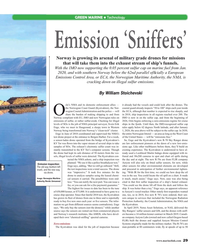 )
May 2019 - Maritime Reporter and Engineering News page: 29
)
May 2019 - Maritime Reporter and Engineering News page: 29Martin Indago drone equipped with in- sels, illegal levels of sulfur were detected. The Kystvakten con- frared and 30x200 cameras to spot and chart oil spills during tacted the NMA ashore, and a ship inspection was the day and at night. The new R-70s are from FLIR company planned. “We use it like a police
-
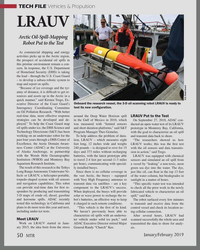 )
January 2019 - Marine Technology Reporter page: 50
)
January 2019 - Marine Technology Reporter page: 50Oil-Spill-Mapping Robot Put to the Test As commercial shipping and energy activities picks up in the Arctic region, the prospect of accidental oil spills in this pristine environment remain a con- cern. In response, the U.S. Department of Homeland Security (DHS) is taking the lead – through the
-
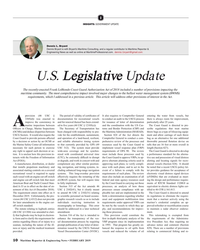 )
February 2019 - Maritime Reporter and Engineering News page: 10
)
February 2019 - Maritime Reporter and Engineering News page: 10greatly en- advance notice and comment (Section ness or injury and the medical treatment mination issued by the USCG National hanced the response to oil spills from 829). There are a number of provisions provided. Vessel Documentation Center (NVDC). vessels and reduced the volume of oil relating to
-
 )
February 2019 - Marine News page: 58
)
February 2019 - Marine News page: 58the antenna sion of H Henriksen’s standard enclosure. Although both antennas Foxtail mop skimmer. Filtering out are electrically the same, the OMNI- oil spills from the seawater using its 402 is specifcally designed for ma- sorbent mops, the FoxTail can op- rine applications and the OMNI- erate in -21°C
-
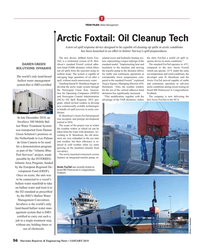 )
January 2019 - Maritime Reporter and Engineering News page: 56
)
January 2019 - Maritime Reporter and Engineering News page: 56in -6°C, sion band (VAB) skimmer, which ? lters insulation to the machine and moving compared to the new Arctic Foxtail SOLUTIONS: INVASAVE out oil spills from the seawater using its the transfer pump to the skimmer allows which can operate -21°C under the same sorbent mops. The system is capable
-
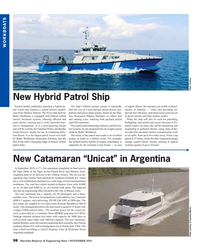 )
November 2018 - Maritime Reporter and Engineering News page: 98
)
November 2018 - Maritime Reporter and Engineering News page: 98can detect surface contamination, such tion threats. It is the largest patrol vessel ever built The needs of the patrol boat made it an excellent as oil spills, from up to ? ve miles away. It has a top by Baltic Workboats (Saaremaa, Estonia), and the project to build as a hybrid vessel. For example,
-
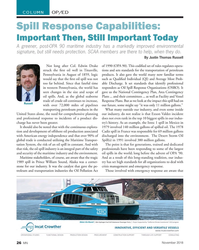 )
November 2018 - Marine News page: 26
)
November 2018 - Marine News page: 26as Oil Spill Response Organizations (OSRO). It seen changes in the size and scope of gave us the National Contingency Plan, Area Contingency oil spills. And, as the global seaborne Plans ... and their committees ... as well as Facility and Vessel trade of crude oil continues to increase, Response
